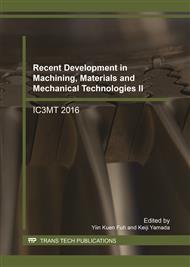p.65
p.70
p.76
p.81
p.87
p.94
p.101
p.107
p.111
Influence of Coolant Application Direction on the Cutting Performance of Ceramic Tool in High-Speed Air-Jet-Assisted Machining of Inconel 718
Abstract:
This paper describes the high speed air-jet-assisted machining of nickel-base superalloy with a SiC whisker reinforced alumina insert. This machining method showed already good performance in high speed machining of Inconel 718. In this paper, the influence of the application direction of coolant on the tool wear and tool life was investigated for obtaining much better cutting performance of the ceramic tool. The coolant was applied from the side of flank face with three different directions: two oblique directions from the end and side flank faces and the perpendicular direction to the cutting edges. In contrast, the application direction of the air jet was always perpendicular to the cutting edges. The experimental results showed that the best performance in the air-jet-assisted machining was obtained by applying coolant from the side of side flank at a cutting speed of 420 m/min and from the side of end flank at a cutting speed of 780 m/min. The necessary condition found for the best performance was that the size of notch wear was a little larger than that of flank wear.
Info:
Periodical:
Pages:
87-93
Citation:
Online since:
August 2017
Authors:
Price:
Сopyright:
© 2017 Trans Tech Publications Ltd. All Rights Reserved
Share:
Citation:



